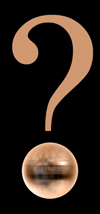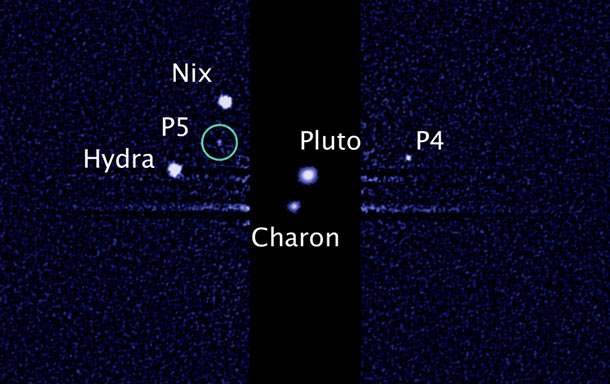A fifth moon for Pluto!

Astronomers have just announced that tiny Pluto has a fifth moon! It was discovered using the Hubble Space Telescope:
You can see it in that image (click to enhadesenate) in the green circle. Pluto was targeted by HST for several observations in late June and early July, and P5 - also called S/2012 (134340), the moon's designation until it gets a proper name - was seen moving around the tiny world. This image is from July 7.
As moons go, it isn't much: it's probably only about 10 - 25 kilometers (6 - 15 miles) across, making it one of the smallest moons detected in the entire solar system. That's actually pretty amazing, given Pluto was 4.7 billion km away (2.8 billion miles) when these images were taken!
Pluto was observed in part to look for more moons. In 2015, the New Horizons probe will zip past Pluto, and scientists want to know as much about the system as they can before it gets there. The odds are low of them hitting any of those moons - space is big, and the moons and spacecraft are small - but a) better safe than sorry, and 2) if there are more targets to observe we want to know now so they can be added to the itinerary!
Observations like this are good for discovering moons and getting their locations, but size is a different matter. Literally. We know how far away the moon is, and how bright, but it's far too small to directly get the size. Its diameter has to be estimated by assuming how reflective the surface is. If it's dark like coal, it has to be bigger to be so bright, and if it's shiny like ice, it's smaller. That's why we don't know P5's size to even within a factor of 2! But once New Horizons zips past, it may be able to nail down the size far better.
The first moon of Pluto, Charon, was discovered in 1978. Nix and Hydra were found using Hubble in 2006, and the fourth moon just last year, in 2011.
 As for the argument about Pluto being a planet or not, this will no doubt provide grist for the mill. However, number of moons does not a planet make; Mercury and Venus have none and they're planets. Mars has twice as many as Earth does, but it's not twice the planet! And many very small asteroids have moons, too.
As for the argument about Pluto being a planet or not, this will no doubt provide grist for the mill. However, number of moons does not a planet make; Mercury and Venus have none and they're planets. Mars has twice as many as Earth does, but it's not twice the planet! And many very small asteroids have moons, too.
My feelings about this are on record: the word "planet" is not and can not be defined; it's a concept, not a definition. It's like the word "continent": it's more of an idea than something you can rigidly define. There is no sharp border that you can use to divide objects into planet and not planet.
So I actually don't care if you call Pluto a planet or not. It is what it is: a very cool object, perhaps the biggest in the Kuiper Belt of frozen icy comet-like bodies past Neptune. It's an oddity, since it's so bright, and yes, has so many moons.
And it's absolutely worthy of study, no matter what you call it.
Image credit: NASA, ESA, and M. Showalter (SETI Institute)
Related Posts:
- Pluto has another moon!
- The unbearable roundness of being
- BAFact math: How bright is the Sun from Pluto? (and the followup, How big does the Sun look from Pluto?)
- Shining shoes for NASA





























